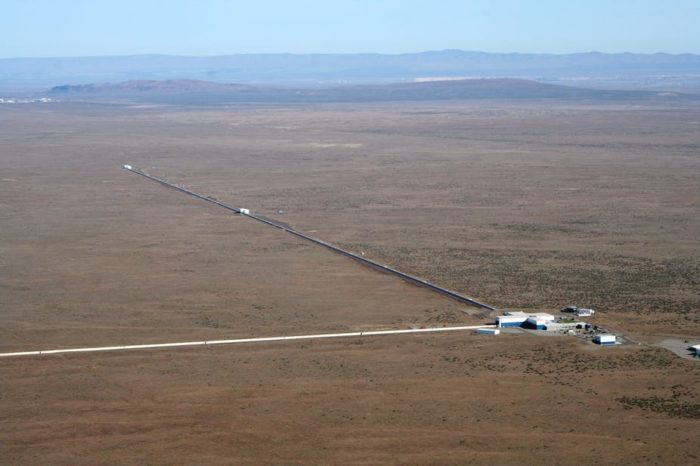Sep 04 2020
Impossible Black Hole Collision Detected
 Of course “impossible” is a relative term here. What is happening is that our knowledge of black holes is greatly expanding because we have a new tool for observing them – gravitational wave detectors. In fact, gravitational wave astronomy is a new science, and we are still on the very steep part of the learning curve.
Of course “impossible” is a relative term here. What is happening is that our knowledge of black holes is greatly expanding because we have a new tool for observing them – gravitational wave detectors. In fact, gravitational wave astronomy is a new science, and we are still on the very steep part of the learning curve.
But let’s back up and give some background. First – what’s a black hole? These are massive objects, mostly stellar remnants. At the end of a star’s life, when it has consumed all the fuel it is capable of fusing, the outward pressure from the fusion is gone and the inward force of gravity prevails. For small suns, like our own, they simply collapse down to a white dwarf, which has, for example, the mass of our sun but the size of the Earth. What keeps a white dwarf from collapsing even further is called degeneracy pressure. The simple (although not complete) explanation for this is the Pauli Exclusion Principle – particles cannot occupy the same state and location at the same time.
Larger stars with larger remnants collapse down even further, overcoming the degeneracy pressure and collapsing down to a neutron star. Again, the simplified version of this is that the electrons and protons merge to form neutrons, so the entire remnant is like one giant neutron. The mass limit for collapsing into a neutron star is about 1.44 solar masses. But also, stars big enough to leave behind a neutron star are also big enough to go supernova. This means the star itself has to be bigger than three solar masses, because much of the mass will be thrown off during the supernova and a smaller remnant will be left behind. Neutron stars are held up by neutron degeneracy pressure.
Even bigger stars that leave behind a stellar remnant of about 3 solar masses or larger, which means the star itself was about 20 solar masses or larger, result in a black hole. The neutron star of 3 M or greater overcomes even neutron degeneracy pressure – in fact, the gravitational force in this situation is greater than any other force we know of in the universe. Nothing can stop that remnant from continuing to collapse, all the way down to a single point in space – a singularity. That is a black hole.
But this is not the only way to form black holes. There are probably primoridal black holes that formed in the early dense universe out of the primordial gas clouds themselves. Also, a neutron star can suck in matter from a nearby companion until it gets over the 3 M limit and then collapses down into a black hole. Neutron stars can collide an then form a black hole. Astronomers also believe that black holes can form in the debris cloud swirling around supermassive black holes.
Also, stars of a certain size, between 130 and 250 solar masses, undergo what is called pair instability:
“Comprehensive models of the late-stage evolution of very massive stars predict that a pair-instability supernova occurs when pair production, the production of free electrons and positrons in the collision between atomic nuclei and energetic gamma rays, temporarily reduces the internal radiation pressure supporting a supermassive star’s core against gravitational collapse. This pressure drop leads to a partial collapse, which in turn causes greatly accelerated burning in a runaway thermonuclear explosion, resulting in the star being blown completely apart without leaving a stellar remnant behind.”
Stars of this size would, if they did not blow themselves completely apart, leave behind black holes between 60 and 130 solar masses. So pair instability predicts there should not be any stellar remnant black holes between 60 and 130 solar masses. This brings us to the new gravitational wave detection.
Gravitational waves are slight (and I mean slight – less than the diameter of a proton) perturbations in space time produced by massive gravitational events, such as the collision of massive objects like neutron stars or black holes. They are detected by powerful lasers far apart and at right angles, so they produce interference. Even the slightest movement of the lasers relative to each other will change the interference in a measurable way. We have the LIGO detector in the US and the Virgo detector in Europe – both of these instruments recently detected the collision of what appears to be two black holes of mass 85 and 66 solar masses. Both of these masses are in the gap where no black holes should be (hence “impossible”).
But as I said, this only applies to stellar remnant black holes that have not undergone previous collisions. This is the first detection of black holes in this mass range – in the gap. This does not mean that the pair instability theory is incorrect. Rather it means that these two black holes got to their mass (prior to the collision) some other way. They may have been the result of previous collisions. They may have been primordial black holes, or formed in the gas surrounding a supermassive black hole. Or they may have been stellar remnant black holes that sucked in neighboring stars or gas in order to grow into the gap.
Now that gravitational wave astronomy is up and running we should expect to detect a lot of firsts, and to flesh out our observations of neutron stars and black holes. This will give us a more complete picture of what’s out there, and in turn inform our theories about what is possible and what is happening.






